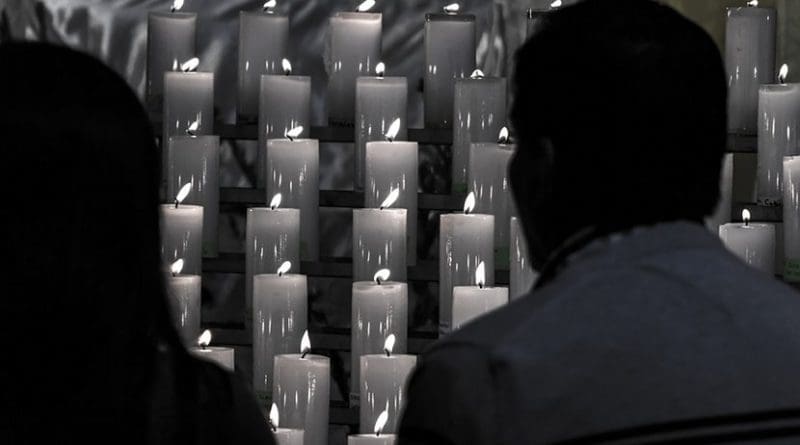Sri Lanka, Martyrdom, And The Light Of Faith – OpEd
By CNA
By Ed Condon
On Saturday night, the Church celebrated its most solemn and joyful liturgy.
As it does every year, the Vigil Mass of Easter began when the paschal candle was lit from a fire burning outside the church.
That candle led the assembly in silent procession into the darkened
church. The priest turned toward the faithful and announced “The light
of Christ!”
“Thanks be to God,” responded the assembly, as the light of the paschal
candle was passed throughout the assembly, flooding the darkened room
with the new light of the resurrection, aglow in the small flames of
hundreds of candles.
At the same time I attended the Easter Vigil Saturday night, a series of
suicide bombs exploded in churches across Sri Lanka, killing nearly
hundreds. The attacks were timed to coincide with Easter Sunday
celebrations.
The transition of the vigil liturgy, from darkness to light, reflects
the procession of the Church from death to life, illuminated by the
light of the Resurrection.
The Easter Exsultet, sung across the world as the bombs detonated in
Colombo, hailed the arrival of the “night in which Christ has destroyed
death.”
Of course the blood-spattered walls and ceiling of St. Anthony’s Shrine
in Sri Lanka offered what appeared to be a macabre juxtaposition to the
empty tomb of the gospel. But through the eyes of faith, and of the
Church, the horrific violence was a witness to the Resurrection of
Christ.
Those Catholics mourning in Sri Lanka know that light — the light — has come into the world, and darkness cannot overcome it.
Sri Lanka is not the only place where churches are burning and
Christians are dying. From Mosul to Cairo, to France, to Kaduna and
Columbo, Christians, the world over, face violence and persecution. But
somehow, in many parts of the West, that reality goes unseen.
The reason is complicated.
The Anglican Bishop of Truro, Philip Mountstephen, has been charged by
the British government with reviewing its foreign policy failures to
address the persecution of Christians worldwide.
Ahead of the publication of his conclusions, and before the Easter
bombings, he told the Times that there is an indifference in the secular
liberal establishement to the plight of Christians around the world. It
is, he suggested, a studied indifference, which misunderstands the
Christian faith as “an expression of white western privilege,”
undeserving of protection.
In a western secular culture defined increasingly by anti-Christian
moral norms, the slaughter of Christians – or “Easter worshippers” to
those too squeamish to use the word – presents a paradox: how can the
religion of white western wealth and privilege be the faith of poor
minorities around the globe? Can the suffering of Christians be
legitimately understood as persecution?
“Actually,” Mountstephen observed, “the Christian faith is
overwhelmingly a phenomenon of the global poor and people who, by their
very socio-economic status, are vulnerable.”
Pope Francis has spoken often of his desire to see “a poor Church of the poor.” In reality, this is what the Church already is.
The killing of the Sri Lankan Mass-goers, like the execution of the
Coptic martyrs in 2015, is a sign of contradiction to a world ready to
believe – and in some cases to print – that Christianity is inseparable
from a kind of capitalistic white supremacy. But the Church is called to
be a sign of contradiction, and such a sign can bear great fruit.
The first Easter vigils in Rome were held in catacombs not cathedrals;
an empire was converted by the witness of uncounted martyrs, whose
unshakable confidence that Christ had risen, destroying death, was a
sign of contradiction to the pagan world.
In his recent essay on the root causes of the sexual abuse crisis, the
pope emeritus noted the “today’s Church is more than ever a ‘Church of
the Martyrs’ and thus a witness to the living God.” Joseph Ratzinger
also famously recalled looking around the Vatican as a young priest and
foreseeing a time in which the signs of wealth and status would be
stripped away.
Caught between the hammer of violent oppression in many parts of the
world and the anvil of a secularized West suspicious if not downright
hostile to the Church, many Catholics see a besieged faithful fighting
for survival.
But in reality, in the gathering darkness, the light of the faith – like
the hundreds of candles light during the Easter vigil – becomes ever
brighter. The violence of persecution stokes the fires of faith.
Many alive now may live to see Ratzinger’s prediction come true:
Francis’ poor Church of the poor once more gathered in the catacombs,
real or metaphorical.
While the world will, like the pagan emperors before, scorn her seeming defeat and irrelevance, the Church will instead draw renewed strength as she becomes ever more truly herself.
The witness of its suffering – as in Sri Lanka – offers the same
witness the martyrs of the early Church offered pagan Rome, and it will
achieve the same result. The experience of the Church in the first
centuries of the third millennium will likely come to resemble that of
the first centuries AD. And from the forge of persecution will come a
New Evangelization to rival the old.
Wedded to her risen spouse and called to share in his glory, those now
confidently burying the Church as a remnant of history are destined to
find her tomb empty. Through death, Christ has already conquered death,
and with him the Church rises victorious.

